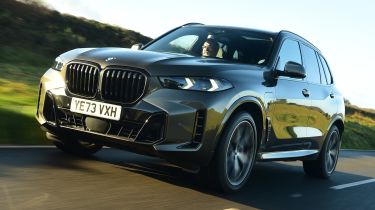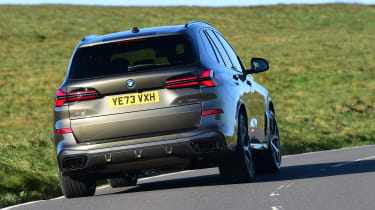BMW X5 - Engines, performance and drive
BMW X5 buyers have the option of either petrol, diesel, or plug-in hybrid power; all offering punchy performance

The BMW X5 is well known for its road-focused driving manners, which remains true with the latest generation. But BMW has included an optional ‘xOffroad’ package with xDrive30d and xDrive40d diesel models. It has four specific loose-surface driving modes, some underbody armour to deflect rocks and bumps, and a mechanical locking differential to maximise traction in slippery conditions. You will also have to add optional adjustable suspension that will enable you to alter the ride height so you may clear obstacles (making this a nearly £5000 package), and in the end, the X5 still won’t be as good off-road as a Range Rover Sport. Still, it should be more than capable enough for most owners.
On the road, models equipped with adjustable suspension (only standard on the M Sport xDrive50e and an option on the rest of the X5 range) have a serene and comfortable luxury-car ride, especially when travelling at motorway speeds, where it remains a peaceful and relaxing mode of transport because it suppresses unwanted wind-, road- and engine noise impeccably. Of course, the plug-in hybrid xDrive50e is even quieter when running on electric power only, and it can do so for up to 65 miles. We thought the switch between petrol and electric is almost imperceptible in ‘Hybrid’ mode, with the engine being a little more vocal in ‘Sport’. The only times we caught the system out was when pulling out of a junction with urgency, where we thought it delivered a little too much performance instead of metering its power out to maintain its composure.
Used - available now
The additional weight of the xDrive50e’s battery pack and its larger 20-inch wheels mean it doesn’t cope as well with speed bumps and potholes at lower urban speeds, but things do smooth out once the pace increases. We’re yet to try an X5 on stock suspension, but when we do, we’ll update this review.
All versions of X5 feature the same super-smooth eight-speed automatic gearbox and a 4x4 ‘xDrive’ drivetrain, although it does send more torque to the rear wheels to emphasise the sporty driving feel. It’s a more rewarding driving experience than SUV rivals such as the Mercedes GLE or Volvo XC90, but a Porsche Cayenne is sharper still.
The ‘Integral Active steering’ option pack adds four-wheel steering to make the X5 feel more alert at higher speeds and easier to manoeuvre when parking. However, we found this a little inconsistent in its responses, which reduced our confidence in the X5’s handling.
0-62mph acceleration and top speed
The xDrive30d uses a 3.0-litre straight-six diesel engine with a single turbocharger and mild-hybrid assistance to deliver 293bhp. It's no slouch, covering 0-62mph in 6.1 seconds and topping out at (where it is legal to do so) 145mph. The xDrive40d uses a twin-turbo version of the same engine and is even more potent at 352bhp. It pulls even harder, getting from 0-62mph in just 5.5 seconds.
The xDrive50e is even more impressive, getting from 0-62mph in 4.8 seconds thanks to its 3.0-litre petrol engine and electric motor working together to produce 483bhp. That’s not far off the output of the M60i, which uses a twin-turbocharged 4.4-litre V8 engine to deliver 523bhp, and can manage 0-62mph in a supercar-rivalling 4.3 seconds.
The standalone X5 M Competition takes the same V8 engine on a stage farther, tuning it up to produce a mighty 617bhp and 750Nm of torque, and dropping the 0-62mph dash to a scant 3.8 seconds.













